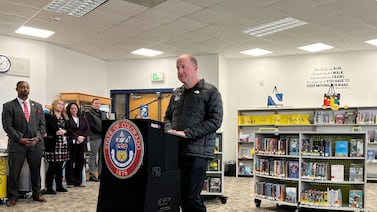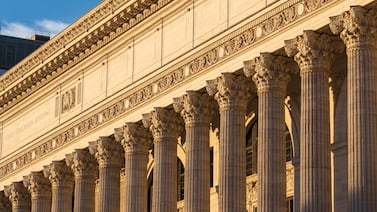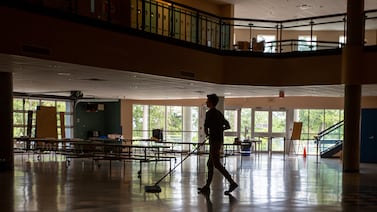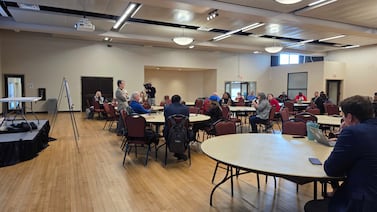Sign up for Chalkbeat New York’s free daily newsletter to get essential news about NYC’s public schools delivered to your inbox.
Zohran Mamdani won Tuesday’s New York City mayoral election, putting the 34-year-old Democratic Socialist in charge of the nation’s largest school system at a time when graduation rates have risen but college readiness is low and too many students are still failing to show up to class regularly.
He won a little more than 50% of the vote, beating former Gov. Andrew Cuomo, who ran as an independent and won roughly 41% of the vote, according to the Associated Press, which called the race with 75% of the votes tallied. Republican Curtis Sliwa trailed with about 7% of votes. Mamdani becomes the first Muslim mayor of New York City.
One of the most pressing questions ahead for the mayor-elect is whether he will end two decades of mayoral control, a governance model that gives the chief executive enormous power over the city’s schools, including the selection of its chancellor.
Mamdani’s campaign galvanized the youth vote, but the Queens state assemblyman didn’t display a deep interest or expertise in education in the race, and he doesn’t have much of a record of school-related legislation from his time in Albany. Until recently, his campaign website devoted just one 168-word paragraph to K-12 education. But overseeing New York City public schools is no small feat: It has a $41 billion budget, 150,000 staffers, and nearly 900,000 students at more than 1,600 schools.
The school system’s graduation rates have soared 30 percentage points over the past two decades, and state test scores for reading and math have improved since the pandemic. But a closer look at a range of metrics reveals that student progress may be more stagnant than some of these figures indicate.
Just 52% of high school students in 2024 were considered ready to succeed in freshman-level college coursework, according to a recent audit from the state comptroller’s office. Students’ scores on the National Assessment of Educational Progress, or NAEP, were essentially the same last year as in 2003. And schools are facing a crisis of chronic absenteeism, with 1 in 3 students missing at least 10% of school last year.
The fate of mayoral control remains murky
Prior to mayoral control, schools were governed by the Board of Education and a decentralized system in which the city’s 32 districts had a lot of power over their own budgets, hiring, and contracts. Complaints about corruption, patronage, and fiefdoms ran rampant.
Today, the mayor chooses the schools chancellor and appoints the majority of members of the Panel for Educational Policy, which votes on major Education Department contracts and school closures.
Mamdani has echoed criticisms that mayoral control gives little say to parents and educators on decisions that directly affect them. He has promised a system of “co-governance” with existing parent councils and school-level leadership teams, though he has offered few details on how that would work.
But how much power he is willing to give up remains to be seen.
“I remain opposed to mayoral control,” Mamdani said at the final debate last month, “and I also believe that the mayor is accountable for that which happens in this city.”
He has yet to define what that accountability means.
Mamdani’s biggest education agenda, free child care — which focuses on the littlest New Yorkers rather than the K-12 system — could prove challenging to enact if the system’s 32 districts are controlled locally. Mayor Bill de Blasio’s ambitious initiative scaling up prekindergarten for 4-year-olds could not have happened without mayoral control, the city’s former chief executive has said.
Lawmakers will consider whether to continue the current system in June 2026. Some education advocates, who met recently with Mamdani’s team, are pushing for a short-term renewal while a commission would create a more detailed plan.
Finding ways to better support teachers
Mamdani, who was endorsed by the United Federation of Teachers in the general election, often talks about the importance of lowering class sizes. To help meet the state’s mandate for capping classrooms — at 20-25 students depending on grade level — Mamdani unveiled a $12 million plan to recruit 1,000 teachers a year by offering tuition assistance to those who commit to teach in city schools for three years.
He also supports Mayor Eric Adams’ literacy and math instruction overhaul, but has emphasized the importance of teachers having more input over how the mandated curriculums are implemented.
In the final debate, Mamdani’s tone on the reading curriculum changes — and the school system overall — shifted a bit, sounding more pessimistic than previously.
“We are not even on track to ensure greater literacy levels across those schools, despite the strides that have been taken with NYC Reads,” Mamdani said. (Reading scores ticked up on the latest state tests, though it’s unclear to what extent the curriculum changes are responsible for those improvements.)
Promises to focus on vulnerable students
When discussing how to fix education, Mamdani has often expressed that larger systemic issues, like homelessness and hunger, need to be addressed too. The city has “grown numb” to the numbers of homeless and hungry children and the segregation in its public schools, he told Chalkbeat on the campaign trail.
“This continues to be a focus for my campaign of putting forward a vision for our school system,” he said.
In responding to a Chalkbeat questionnaire about the most pressing problems of the city schools, he offered some hints that he’d want to focus on the system’s most vulnerable children, including students with disabilities and homeless children. Roughly 154,000 students lived in shelters or doubled up with other families or friends last year, a record high.
He also said he’d support the city’s community school model, providing wraparound services, such as mental health or dental clinics and other social services. The city currently runs more than 400 community schools, and the city’s teachers union supports the model, which has shown some promising results.
Stirring up debate on gifted programs
Mamdani recently reopened a long-running debate over the city’s gifted and talented program in elementary school, saying he wanted to eliminate gifted classes with a kindergarten entry point.
The program has come under fire by integration advocates since it enrolls disproportionately few Black and Latino students relative to their population in the school system as a whole. In the past few years, the program switched from basing admissions on a test given to 4-year-olds to teacher recommendations. Teachers, however, overwhelmingly recommend students.
New York remains an outlier in sorting in kindergarten for gifted and talented programs.
Mamdani did voice support for keeping gifted programs starting in third grade. But many of the programs for third graders, started by the Adams administration and focused on undeserved areas, have failed to gain traction.
And while Mamdani has expressed interest in overhauling gifted programs, he backed away from previous calls to eliminate the Specialized High School Admissions Test, which serves as the sole basis of entry for eight high schools, including Mamdani’s alma mater, Bronx Science.
Mamdani has also discussed tackling problems with Education Department procurement and expanding solar panels on schools. His overarching vision for the school system, however, remains opaque.
“We’ve been wanting to see how these different ideas fit together,”Jonathan Collins, professor of political science and education at Columbia University Teachers College, previously told Chalkbeat, “and instead he’s been pivoting from one idea to another.”
If you are having trouble viewing this form, go here.
Amy Zimmer is the bureau chief for Chalkbeat New York. Contact Amy at azimmer@chalkbeat.org.
Alex Zimmerman is a reporter for Chalkbeat New York, covering NYC public schools. Contact Alex at azimmerman@chalkbeat.org.






